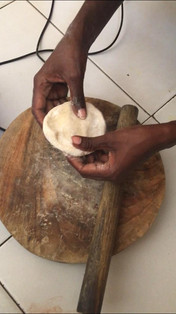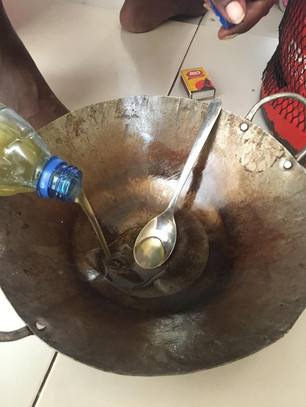A culinary guide to Tanzania
- Vera

- Jul 9, 2019
- 3 min read
As you may or may not know I am a foodie. I spend most of my money on grocery shopping and dinners with friends, so it is no surprise that I was very keen on experiencing the various flavours of Tanzanian cuisine.
The food experience starts at the market. The colours and the exotic scents stimulate the senses and invite to buy fresh vegetables and fruits - totally plastic-free (YAY)! I do one big food shop on the weekend and stock up on any essentials during the week.
The next step is the cooking. Usually, I cook and eat at home. However, I enjoy the occasional indulgence and will get a meal from a 'restaurant' or bar in town. My top picks are Makutano for Kuku choma (grilled chicken) and Two in One for Mshikaki na chipsi (kebabs and fries). Both are considered traditional Tanzanian dishes but there are many more:
1. Ugali is the meal that is considered THE Tanzanian national dish. It is a sticky dough. It's main ingredient is cornmeal. To my very disappointment I am not an Ugali fan. It is usually the cheapest and easiest carb-option on an average Tanzanian plate but my palate cannot appreciate the flavour-less porridge.

2. Much more to my liking are nyama choma which translates to grilled beef. This delicious option is best served with chipsi or cooked bananas. As a sauce they suggest pili pili (chili), tomato sauce or chicken broth. This is also the Tanzanian version of a night-out-4-in-the-morning-hungry-after-dancing-for-hours snack.
3. Famous, especially in Zanzibar and the coastal region, is Pilau rice. Where Ifakara and Iringa are famous for their quality rice, Zanzibar is famous for spices. And the two combined result in this mouth-watering culinary experience. The rice is seasoned with ginger, cloves, cardamom and cinnamon. As a variation of the dish, vegetables can be added into the mix for some extra flavour.
4. My everyday bread, so to speak, is Wali na Maharage: Rice and Beans. At the hospital canteen it is served with a Mchuzi, a sauce, made out of tomatoes, and vegetables (= mboga). Healthy, filling, cheap and practical - it is the perfect everyday food for the working and farming class.
5. And now to my favourite. Chapati. It was my first food discovery and it was love at first bite. This delicious flatbread is a perfect mixture of a tortilla, a naan bread and crêpe. It is neither savoury nor sweet and can be eaten with avocado, beans but also nutella or honey. It is the perfect breakfast, lunch and dinner.
Luckily, my very dear friend Jackie, knows all about how to cook Chapati which is why I urged her to teach me.
- The dough is simple: White flour and hot oil are mixed together in a bowl until the flour is slightly sticky but not clumpy anymore. Then, hot water with some salt is added gradually into the mix. Once the dough is smooth and soft and not sticky you start forming little portions.
- Each portion is rolled out into a thin tortilla.
- Each tortilla is then baked in a frying pan and as soon as the dough is starting to get golden-brown some oil is added with a spoon to avoid it sticking to the pan and ensure a crispy outside. Done!
The chapati were then served with freshly cooked Maharage (beans) and some liver stew.

Additional to art, common traditions, history and religion, food is a very important factor in the culture of a country and its peoples. It's not only the ingredients and recipes but also the rituals regarding shopping at the market, cooking, sitting together at a table or on the floor, eating with cutlery or with hands that make up a culinary identity of a place. It is one of my favourite experiences when travelling to other countries, even the ones who are close to home.
It goes without saying that there are a lot of things I miss about the food at home such as diary products, good chocolate and my Dad's Parmigiana or my Mom's Spätzli. However, I am sure that I will take home some new ideas and recipes as well as some actual spices, of course, and I will try to preserve a little bit of Tanzania on my plate.








































Comments